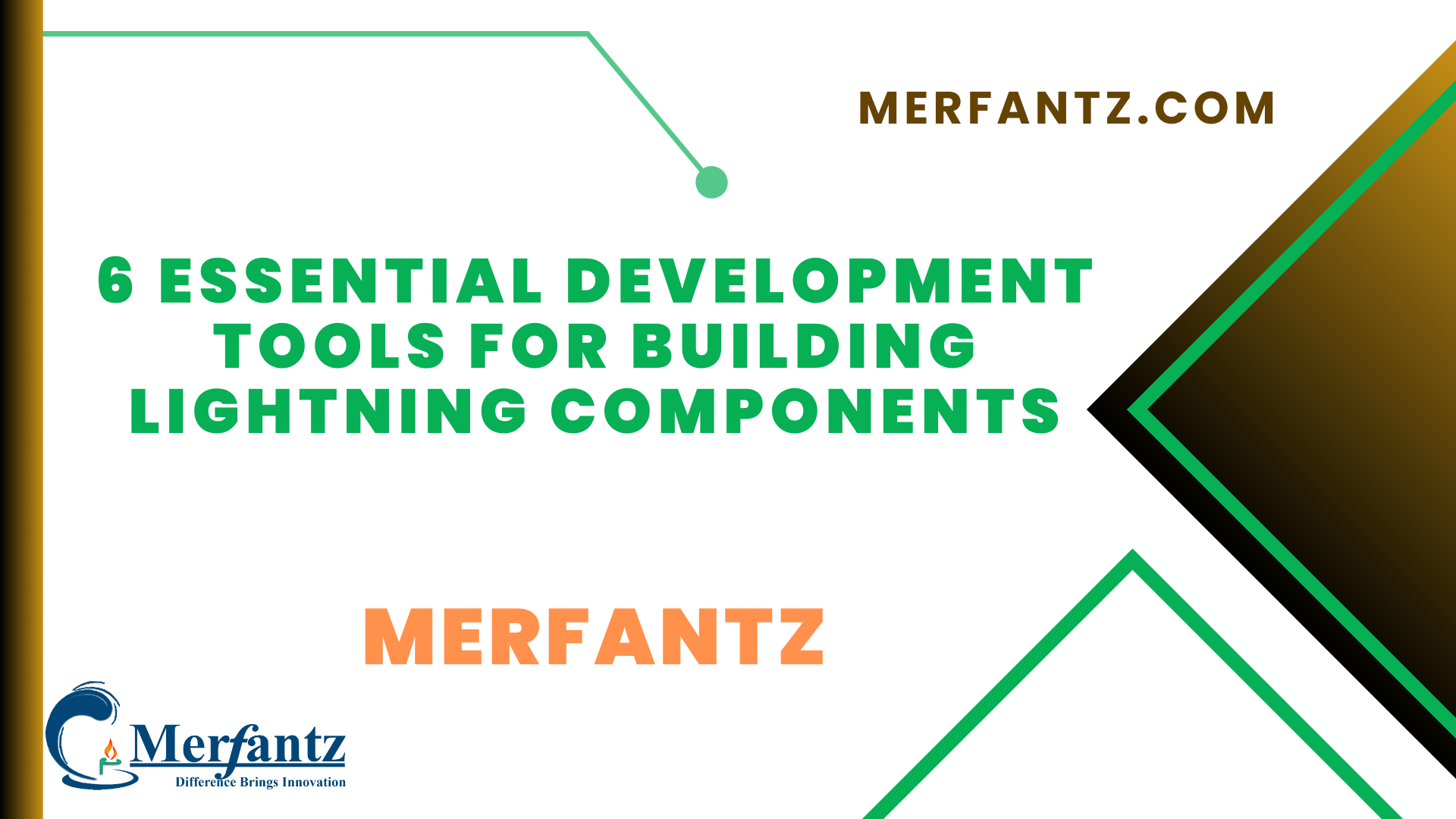Introduction to Lightning Components
In today’s fast-paced digital landscape, Salesforce Lightning has emerged as a powerful platform for developing dynamic and interactive applications. Lightning Components serve as the building blocks of these applications, enabling developers to create feature-rich and scalable solutions. Whether you are a seasoned Salesforce developer or new to the ecosystem, understanding the essentials of Lightning Component development is crucial to unlocking its full potential.
At Merfantz Technologies, we recognize the significance of Lightning Components in empowering businesses with cutting-edge applications. In this blog post, we will explore the six essential development tools that can elevate your Lightning Component development journey. From foundational Aura Components to the latest Lightning Web Components (LWC), we will delve into the tools that streamline your development process, enhance productivity, and foster innovation.
Aura Components: The Foundation of Lightning
Aura Components form the bedrock of the Salesforce Lightning framework. These reusable and encapsulated units of functionality enable developers to create robust applications with modular architecture. The Aura framework provides a powerful set of tools and features that facilitate seamless communication between components and efficient data handling. As a result, developers can build complex applications with ease while maintaining a high level of performance.
Merfantz Technologies understands the significance of mastering Aura Components for proficient Lightning development. With our expertise, you can harness the true potential of this foundation to create scalable and adaptable applications that meet your business needs. Let’s explore how Aura Components serve as the backbone of your Lightning journey and how you can leverage them to their fullest.
Lightning Web Components (LWC): Modern Customization
Introduced as part of the Lightning Web Components framework, LWC represents a significant advancement in the Salesforce ecosystem. LWC follows a modern and standards-based approach to web development, allowing developers to leverage the full potential of modern browsers and frameworks. Its lightweight architecture and enhanced performance make it a preferred choice for building lightning-fast applications that deliver a seamless user experience.
At Merfantz Technologies, we recognize the game-changing impact of Lightning Web Components in customizing and personalizing Salesforce applications. Our team of experts can guide you through the process of developing Lightning Web Components, helping you unlock the power of modern web development in the Salesforce ecosystem. Let’s explore how LWC can take your customization efforts to the next level.
Unleashing the Power of Visual Studio Code with Salesforce Extensions
Visual Studio Code (VS Code) is a popular and feature-rich code editor that has gained immense traction in the developer community. With the availability of Salesforce Extensions, developers can now harness the full potential of VS Code to build Lightning Components seamlessly. The extensions provide specialized tools, intelligent code completion, and debugging capabilities that streamline the development process and improve code quality.
At Merfantz Technologies, we understand the significance of choosing the right development environment to maximize productivity. With VS Code and Salesforce Extensions, our developers can accelerate the development of Lightning Components while maintaining the highest standards of code integrity. Discover how our team leverages these tools to ensure the success of your Salesforce projects.
Best Practices for Lightning Component Development
Creating efficient and scalable Lightning Components requires adherence to best practices and coding standards. With Salesforce’s continuous updates and improvements, staying up-to-date with the latest best practices is essential to ensure your applications are future-proof. Understanding the do’s and don’ts of Lightning Component development empowers you to build maintainable and high-performing solutions.
Merfantz Technologies takes pride in adhering to the industry’s best practices for Lightning Component development. Our experienced developers are well-versed in the latest standards and follow a robust set of guidelines to deliver top-notch applications to our clients. Explore the best practices that drive the success of our Lightning Component projects.
Creating Visually Stunning Interfaces with Salesforce Lightning Design System (SLDS)
User experience is a crucial aspect of any application’s success. Salesforce Lightning Design System (SLDS) offers a comprehensive set of guidelines and resources for designing visually appealing and consistent interfaces. By adopting SLDS, developers can create a seamless user experience that aligns with the overall Salesforce look and feel, enhancing user engagement and satisfaction.
At Merfantz Technologies, we recognize the importance of an intuitive and aesthetically pleasing interface in driving user adoption. Our team of designers and developers collaborates to implement SLDS effectively, ensuring that your applications not only function flawlessly but also captivate users with their stunning design. Discover how SLDS can elevate the interface of your Lightning Components.
Integrating Apex and Backend Services in Lightning Components
Salesforce Lightning Components often require integration with backend services and Apex controllers to fetch and manipulate data. Integrating Apex and backend services efficiently is crucial for creating dynamic and data-driven applications. Developers must understand how to establish seamless communication between the frontend Lightning Components and the backend logic to ensure a smooth user experience.
At Merfantz Technologies, we possess extensive experience in integrating Apex and backend services in Lightning Components. Our skilled developers can guide you through the intricacies of backend integration, enabling you to build feature-rich applications that leverage the full potential of Salesforce’s data capabilities. Let’s explore how seamless integration can elevate your Lightning Component development.
Achieving Accessibility in Lightning Development
Inclusive design and accessibility have become imperative considerations for modern applications. Salesforce Lightning Development offers features and tools that support building accessible applications to ensure that everyone, regardless of ability, can access and use them. Ensuring accessibility compliance not only broadens your user base but also aligns with ethical and legal obligations.
Merfantz Technologies is committed to delivering inclusive and accessible applications to our clients. We understand the significance of creating interfaces that accommodate all users, and our development practices reflect this commitment. Explore the strategies and tools we employ to achieve accessibility excellence in Lightning Component development.
Frequently Asked Questions (FAQ) – Salesforce Lightning Development
What is Salesforce Lightning Development?
Salesforce Lightning Development refers to the process of creating dynamic and interactive applications on the Salesforce platform using Lightning Components. These components are reusable building blocks that allow developers to build feature-rich and scalable applications with a modular approach. Lightning Development empowers businesses to deliver seamless user experiences, streamline workflows, and enhance productivity.
What are Lightning Web Components (LWC)?
Lightning Web Components (LWC) are a modern approach to building components in the Salesforce ecosystem. LWC follows standard web development practices, leveraging the latest web standards and frameworks. With a lightweight architecture, LWC offers improved performance and flexibility, enabling developers to create lightning-fast applications.
How can Salesforce Extensions enhance the development process?
Salesforce Extensions for Visual Studio Code (VS Code) provide specialized tools and capabilities that enhance the Lightning Component development process. These extensions offer intelligent code completion, debugging support, and integration with Salesforce metadata, enabling developers to write efficient and error-free code.
Why is adhering to best practices essential in Lightning Component Development?
Adhering to best practices in Lightning Component Development ensures that the applications are built with maintainability, scalability, and performance in mind. Staying up-to-date with the latest industry standards and Salesforce updates future-proofs the applications and ensures they remain compatible with evolving technologies.
What are the tools included in Lightning?
The tools included in Salesforce Lightning are:
- Lightning App Builder: For building custom user interfaces with drag-and-drop components.
- Lightning Components: Reusable building blocks for application development.
- Lightning Design System (SLDS): Provides design guidelines and resources for consistent UI.
- Aura Framework: The foundation for building web applications with Aura Components.
- Lightning Web Components (LWC): A modern approach to building components using standard web technologies.
How do we develop Lightning components?
To develop Lightning components, we use the Salesforce Lightning Component Framework, which consists of two main types:
- Aura Components: Developed using the Aura Framework, supporting both client-side and server-side controllers.
- Lightning Web Components (LWC): Built with modern web standards like JavaScript and HTML, leveraging the power of web components.
What are the tools in LWC?
The tools used in Lightning Web Components (LWC) development include:
- Visual Studio Code (VS Code): A popular code editor with Salesforce Extensions for LWC development.
- Salesforce CLI: Command-line interface for managing Salesforce development tasks, including LWC.
What are standard components in Lightning App Builder?
Standard components in Lightning App Builder are pre-built components provided by Salesforce. They are ready-to-use and can be added to the user interface using drag-and-drop in the Lightning App Builder. Standard components cover a wide range of functionalities, such as charts, lists, forms, and navigation elements, making it easier to create custom interfaces without extensive coding.
Conclusion:
In conclusion, Salesforce Lightning Development opens up a world of possibilities for businesses seeking to build cutting-edge applications. From the foundational Aura Components to the modern Lightning Web Components, mastering the essential development tools discussed in this blog can empower your business to thrive in the digital era.
At Merfantz Technologies, we are dedicated to helping businesses harness the true potential of Salesforce Lightning. Whether it’s developing visually stunning interfaces, integrating backend services, or adhering to best practices, our team of experts is equipped with the knowledge and experience to deliver top-tier Lightning Components that drive success. Contact us today to embark on your Salesforce Lightning journey and elevate your business to new heights.
Author Bio
Co-Founder & CMO at Merfantz Technologies Pvt Ltd | Marketing Manager for FieldAx Field Service Software | Salesforce All-Star Ranger and Community Contributor | Salesforce Content Creation for Knowledge Sharing






